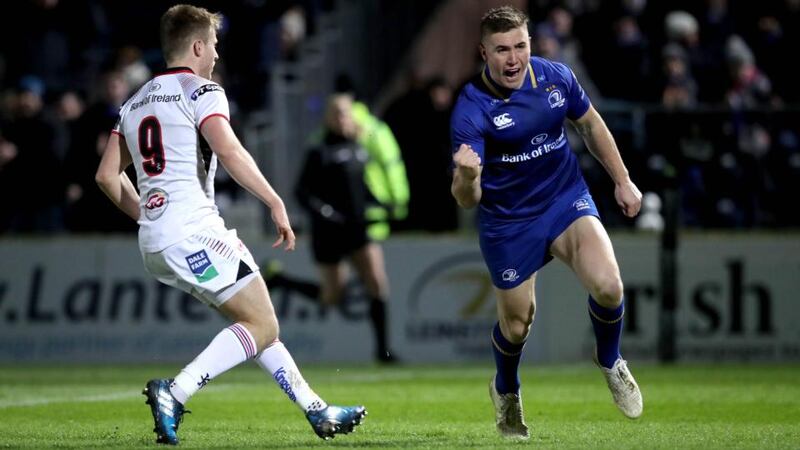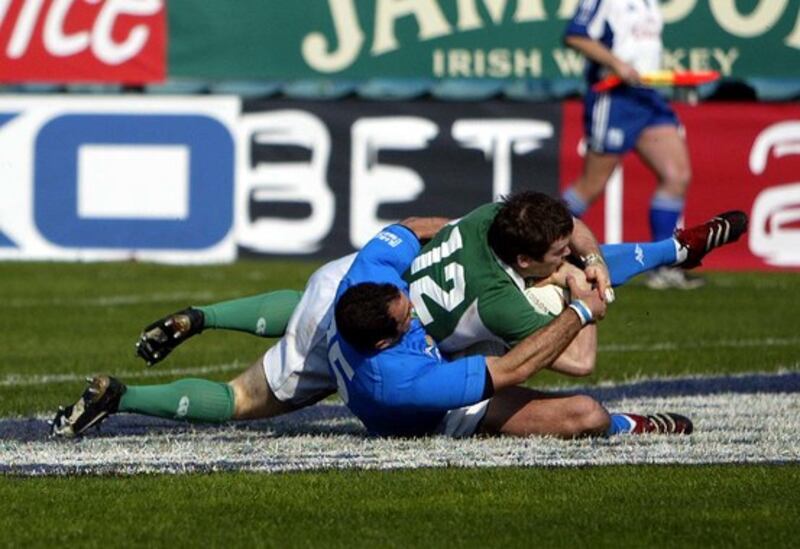Any sustainable culture must be learnt not taught.
Leinster’s ground-breaking years were enveloped by the tough love environment created by Michael Cheika which evolved into a leadership driven culture where the minutiae coaching of Joe Schmidt became our unassailable strength. Then almost everyone retired (and Johnny Sexton departed) in the same two year period under Matt O’Connor.
Now, clearly, Leinster players have put in place a new value system that primes them to become just as successful as the 2009-12 era.
Crucially, these values are not the same as what went before. They have carved out their own beliefs.
Jordan Larmour is a very tasty cherry on top of it all.
But take a breath. If Larmour and Jacob Stockdale swapped jerseys last Saturday at the RDS a reversal of fates could have occurred. Leinster’s pack eroded Ulster. Playing behind such a malaise is next to impossible. Even Charles Piutau looked mortal. We know that’s a mirage. Ulster’s problems are deeply rooted in their culture.
Larmour would have been exposed by the same players ripping through the defensive line as much as Stockdale would have taken flight in a blue jersey. As he did for Ireland in November.
Both young men possess fantastic attacking gifts. Stockdale is being sternly tested now, as Larmour will be eventually. It’s too easy to brand him the next D’Arcy, O’Driscoll, Garry Ringrose or whoever else.
There’s an obvious difference between a Clongowes fullback straight from school in 1998 to Jordan Larmour in 2018. He can catch and kick, I couldn’t.

There’s a reason for that too. Conor O’Shea was my fullback mentor for six months in and around the 1999 World Cup. Then Conor moved on and I was winging it again.
You can be cursed by your own talent in Irish rugby. I was an outhalf at age 15. I was only starting to develop the understanding that allows a playmaker bring others into the game with the flick of a wrist – the sort of passing we see Johnny Sexton and Joey Carbery fire off with consummate ease, that obviously takes years to develop – when my rugby took a different course.
I look back now and wonder about becoming that sort of player but speed and footwork got me promoted to the Clongowes senior cup side in fourth year as a winger. I moved to fullback but straight into professional rugby I was the kid with pace to finish off tries.
It was five more years before Gary Ella put me at outside centre. Another season passed before I settled into life at number 12. Already 24-years-old, I was never going to reach the proficiency of a second-five-eight like Matt Giteau. I could see the body language of team-mates and the flicker of opportunity to thread a kick through without being able to pull it off. A frustrating existence; being able to see something but unable to capitalise through a lack of confidence or developed skill.
Strongest attributes
I made do by constantly enhancing my known strengths, like entering contact on my own terms. Footwork and doggedness remained my strongest attributes.
It was still the life of kings.
Larmour is living it now. He certainly looks the part. When I was his age, props were still props and they weren’t hard to find. I knew I’d make a few 60, 70 metre breaks in every game. I also realised I could dine out on them.
It doesn’t work like that anymore.
We haven’t seen enough of Jordan to know whether he’s a natural fullback, wing or centre. Yet we are always quick to brand him the next whoever. He can become any of the above – past players or positions – but only time and good fortune will inform us. Maybe he can do something really special like Adam Ashley-Cooper; a player that will cause the same damage no matter the position.
The point is the world is at his feet and that never lasts but Larmour will be fine because he exists within a culture he would have helped shape.
I landed into an amateurish environment. I was playing for Ireland, Leinster and still training with Lansdowne. The ‘win or lose we’re on the booze’ mentality passed with the 20th century rugby player.
Larmour and his peers attained a level of professionalism as teenagers that took me a missed World Cup in 2003 to even begin to comprehend. There was plenty of fun along the way but was it worth it?
Not really.
The memories I cherish from my career aren’t off field celebrations or commiserations – serious craic that they were – rather those seconds on the Cardiff grass in March 2009, followed two months later by the final whistle at Murrayfield. They are the feelings I kept chasing until happily walking away in August 2015 having given everything I could.
That feeling of total satisfaction is fleeting. The Grand Slam and winning our first Heineken Cup only made me want the same high again. And again.
But it took a while for the penny to drop, for the collective culture to get me to meticulously drag the best from myself. I’d been a pro since 1998 so there were some wasted years until 2001.
None of my early career antics would be accepted today. The current generation understand this. We paved the way but they must seek an ever higher standard from the demands of this increasingly punishing game. Going on the beer, in some instances, was my way of self sabotaging the privileged position that raw ability had attained. Winging it. Old Testament rugby. That little voice in your head. You’re not good enough. You’ll be caught out eventually.
Different breed
A head space that was eventually replaced by a process focused approach.
Today’s young lads are a different breed. Same route, with a vastly different landscape growing up around it because of moments that change us forever. That changed Leinster, and changed Irish rugby.
Denis Hickie – the original Jordan Larmour – did something unusual in the changing room before we played Italy in 2007. He spoke. Den had made up his mind to retire after the World Cup later that year, he just hadn’t told anyone. To win the Six Nations we needed an avalanche of points in Rome, and for Scotland to do us a favour in Paris. I don’t remember exactly what he said but I’ll never forget the look in his eye. The intent. These chances only come along every once in a while. I played one of my best games that day, in any jersey ever, and so did everyone else. We ran riot, winning 51-24 but came up agonisingly short due to a few twists of fate.
Johnny Sexton had that same look at half-time of the 2011 European final. Can’t for the life of me tell you what he said but I remember how I felt after he said it.
Key influencers drive the collective sense of belief. They drive the culture the players created for themselves.
Learnt not taught.

When things are going unbelievably well, as we are seeing with Leinster, good coaches keep players in tunnel-vision mode, but when things go off kilter a culturally well-armed squad never panic.
See Saracens in December. They may have lost their European title with back-to-back defeats to Clermont but if that’s the case be damn sure they’ll recapture the English Premiership.
So December defeats proved of enormous value to Saracens. Having dominated European rugby for two seasons, what outwardly looks like a crisis actually provides a platform for them to rediscover their ruthless streak. Mark McCall and the coaches presumably got out of the players’ way. Let them problem solve among themselves. That’s what great teams do. They are still at their peak and great players thrive off such adversity.
Leinster appear to be at the start of a similar climb. They are certainly out the other side of their regeneration phase. Recovering to beat Exeter in Dublin highlighted their culture’s strength and how much they can rely upon it under severe pressure. It’s true, you learn more from defeat than victory but sometimes you need to win. This Leinster group needed to come back and beat the English champions. That they did it without Johnny provides proof the whole value system is working.
Muscle memory
How they reacted on the field when Cian Healy was sin-binned told me that their new identity has taken root. When the pressure came they didn’t do anything different, they refused to panic, they adjusted defensively and build phases into scores. That’s a muscle memory now to be tapped into by Luke McGrath, Tadhg Furlong, Josh van der Flier, Dan Leavy and so on.
Amidst all of this, Larmour tears through Ulster (twice) and Munster defences for stunning tries.
I’m not going to try and read Joe Schmidt’s mind but at some stage he will piece together his best team for the 2019 World Cup. Maybe that will happen in Paris next month. Two Six Nations, a three-Test series in Australia and a November series before Japan 2019 gives Ireland 16, maybe 17 competitive matches.
It all feeds into the decision-making process of when Larmour plays again for Leinster or if he gets capped by Ireland. Be it the Six Nations or summer tour or, like Garry Ringrose, he is held until November. Let him shine for Leinster. Let his body get used to the physicality because, as Ringrose is showing, there will be setbacks.
All this happens within a harmonious culture ably curated by experienced mentors. Stuart Lancaster’s enormous value cannot be ignored. He renovated the English culture from academy into senior ranks and until the 2015 World Cup only Clive Woodward had a more successful record as national coach. Same goes of Leo Cullen’s time at Leicester before and after living the golden Leinster years.
The true beginning of the new cycle was evident against Exeter in December. With Larmour gliding above it all. I remember those days. It really is the life of kings.













